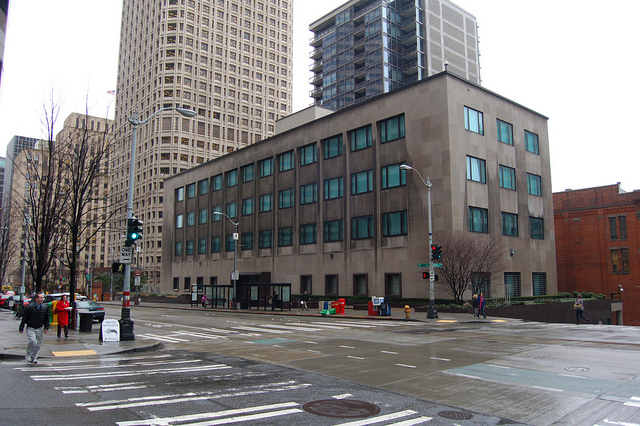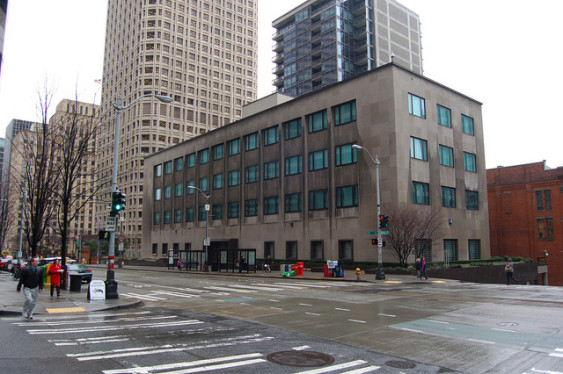The prospects for a downtown Seattle school brightened somewhat yesterday, with a unanimous school board vote allowing the district to bid on the empty Federal Reserve Bank building at the corner of 2nd Avenue and Spring Street.
The federal government is auctioning off the vacant building—which is the right size to house 660 students—to the highest bidder. With the auction closing next Wednesday, no one has submitted a bid so far. But the school district will likely have competition—at least one other entity has paid the auction’s $100,000 registration fee, officials have said.
The feds reduced the minimum bid from $5 million to $1 million last week, and buying the building outright would remove timing and funding issues that were earlier stumbling blocks for the district.
Seattle remains the largest Northwest city without a downtown public school, and opening one has been the top priority for a growing number of urban parents who want to raise families in downtown Seattle. Many move to the suburbs or other Seattle neighborhoods before their kids enter kindergarten. The ones who plan to stay argue their kids should have the same access to a convenient neighborhood school as families living elsewhere in the city. As downtown parent Michael George put it:
This would be a gamechanger for us. A downtown school is more important than any other issue. Its not just about having a school. Right now having a family with kids downtown is difficult because there aren’t many playgrounds and there isn’t a place to create a community around. What a school would do is help kids and parents from throughout downtown connect around something. I think that’s what we’re really looking for.
Parents and downtown advocates have worked for years to find a viable parcel of land or a developer who would be willing to include a school in a new project. So far, none of those efforts have borne fruit. The downtown Federal Reserve Bank Building, which the federal government wants to offload because it’s no longer in use, is a 90,000-square foot concrete behemoth in the heart of downtown. It is listed on the National Register of Historic Places, and a preservation covenant held by the state with would prevent a new owner from tearing it down, which makes it less attractive to a private developer.
Seattle Public Schools officials, understandably, haven’t said how much they’re willing to pay at auction. The board authorized the superintendent to pay up to 10 percent above its estimated value, but the district hasn’t yet made the appraisal public.

Salmon Bay K-8 School by Joe Wolf used under CC BY-ND 2.0
The Seattle school district had the chance to acquire the building for free through a federal disposition process, but the school board passed on that opportunity last November. The district would have been under a 3-year deadline to get the school up and running, and there was no guaranteed source of funding to renovate it that quickly.
If the district buys the building at auction, it could re-purpose it on its own timetable. The costs to transform the Cold War-era building into a warm and fuzzy elementary school are estimated to be $53 million. The district would have enough breathing room to include those costs in the next school construction levy, which will go before voters next year.
Having that flexibility turned the school board’s unanimous “no” vote in November into unanimous support for trying to buy the building now. As school board president Sherry Carr said:
I’m very enthusiastic about being able to support this. There’s nothing that breathes life into a block or our city or the downtown core that’s been shuttered…than our young children.
The Federal Reserve Bank building could house 660 elementary students. Adding that same amount of capacity by expanding existing elementary schools nearby would carry a price tag of $64 million, according to a district analysis.
A new downtown @seapubschools could serve 660 #Seattle students.
There are arguably enough nearby elementary students to fill the school already. As this map shows, there are 427 SPS students enrolled in grades K—5 who live within a one-mile radius of the building, and 1026 enrolled students living within a mile and a half.
And more are on the way. A Downtown Seattle Association analysis found that more babies were born in 2011 to families living downtown than any other school attendance area in the city. Downtown resident Grace Leong told the school board Wednesday that when she first moved into her building more than a decade ago, there was one school-age child living there. Now, there are four, with three preschoolers close behind.
The district will have to accommodate some portion of those new students, whether they move to outlying areas of Seattle or stay put. Without a neighborhood school to serve them, downtown kids will eventually overcrowd existing schools. Many downtown families had to be reassigned this year from John Hay Elementary in Queen Anne, which was over-enrolled and too crowded, to Lowell Elementary on Capitol Hill.
In either case, it’s difficult for downtown families—some of whom do not own cars—to manage those logistics. It’s tough for kids who are currently bussed to Lowell or Bailey Gatzert to take after-school art lessons or sign up for a play or join a running club because there’s no transportation home at 4 pm, George said:
Its easy to say ‘you can just take the school bus,’ but it’s not that easy when you have two kids and an after school something. The school bus takes you to school and back but it doesn’t help you when you need to go to your son’s play. So we’re going to go to places like North Seattle and put more pressure on those schools. One thing that having a school downtown does is relieves the pressure on other areas.
During Wednesday’s vote, Seattle’s school board directors seemed to agree. Sharon Peaslee appealed to other bidders who might be lurking out there, essentially asking them to bow out of the auction and let the district win:
We know that sometimes everybody waits until the last minute and jumps in. I just hope that the citizens of Seattle who are eyeing this building will have enough of a civic conscience to recognize that it will probably serve the students of Seattle better than it will serve them.











